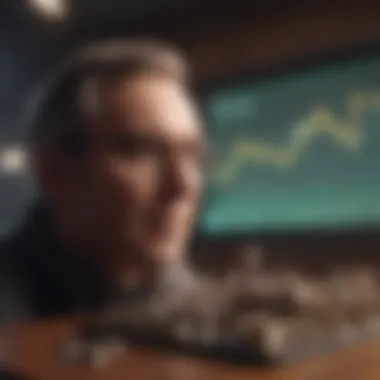VTSAX Stock Forecast: Insights and Analysis


Intro
In the vast landscape of financial investment, understanding how to navigate through various funds is crucial for building a robust portfolio. VTSAX, or Vanguard Total Stock Market Index Fund, stands out as a prominent choice among individual investors. This analysis will take you on a deep dive into the intricacies surrounding VTSAX, focusing on market indicators, historical performance, and expert insights.
As we embark on this journey, it’s essential to grasp the underlying dynamics of financial products in general, and how they serve as the building blocks for smart investing. The insights from this piece aim to equip both novice and experienced investors with a clearer view with the hope that you can make well-informed decisions.
Overview of Financial Products
Definition and Significance
Financial products encompass a wide range of options available for investment, each designed to meet specific investment goals and risk appetites. These products can be broadly categorized into stocks, bonds, mutual funds, and exchange-traded funds (ETFs), amongst others. The significance of understanding these products lies in their varying structures, returns, and risks, which are pivotal for shaping investment strategies.
Types of Financial Products Available
- Stocks: Represent ownership in a company, offering capital gains and dividends to shareholders.
- Bonds: Fixed-income instruments that provide regular interest payments and return principal upon maturity.
- Mutual Funds: Pooled investment vehicles managed by professionals, often providing diversification across numerous securities.
- ETFs: Similar to mutual funds but trade like stocks on exchanges, offering greater liquidity.
Understanding these products is foundational for evaluating performance, including the outlook for funds like VTSAX.
Key Attributes
Interest Rates and Returns
When assessing any financial product, interest rates and returns profoundly impact investment decisions. For VTSAX, being an index fund, returns are generally aligned with the performance of the total stock market. Over the long term, this can result in substantial appreciation, but it may vary according to market cycles.
Risk Factors Associated with Each Product
Risk is an inevitable part of investing. Each type of financial product comes with its own risk profile. For instance:
- Stocks: Higher potential for returns but with increased volatility and potential for loss.
- Bonds: More stable but may offer lower returns, especially in a low-interest-rate environment.
- Mutual Funds: The risk varies based on underlying holdings, but there is a degree of management risk involved.
- ETFs: Subject to market risks like stocks, yet can be a strategic choice for diversifying risk.
"Investing is not just about making money; it's also about managing risk effectively.”
These attributes serve as a compass for understanding VTSAX’s potential, setting the tone for the deeper analysis ahead. With these fundamentals in mind, investors can better navigate the complex world of stock investing.
Understanding VTSAX
Understanding VTSAX is crucial for anyone aiming to navigate the intricate world of investments. This section lays out the essentials of this particular stock, steering investors towards smarter decisions. VTSAX, short for Vanguard Total Stock Market Index Fund Admiral Shares, offers a window into the broader U.S. stock market. This makes it indispensable for both novice investors and seasoned professionals.
The heart of this article dives deep into various facets, including what VTSAX truly represents, how it’s constructed, and the strategies that can be employed when investing in it. Knowing these details can bridge the gap between uncertainty and informed decision-making, enhancing one's confidence in investment choices. To put it simply, grasping the fundamentals of VTSAX empowers investors in selecting the right paths in a volatile financial landscape.
What is VTSAX?
VTSAX is a mutual fund that aims to track the performance of the CRSP US Total Market Index. This fund is designed to provide exposure to the entire U.S. stock market. In other words, it encompasses stocks of companies from every sector, providing a broad spectrum of growth opportunities. Want to invest in big corporations? It’s got you covered. Looking for that small start-up that's buzzing with potential? You're in the right place. VTSAX brings the entire market into a single investment, melding convenience with diversity.
But it's not just a mouthful of initials. Private investors view VTSAX as a relatively low-cost option with a relatively high internal efficiency. The beauty of VTSAX lies in its simplicity; you can own a slice of every stock available without having to pick and choose.
Composition of VTSAX
The composition of VTSAX is notable for its broad reach across various market capitalizations — large, mid-size, and small. A survey of the fund's holdings reveals a mix that includes tech giants like Apple and Microsoft, alongside up-and-coming firms in various sectors. Here's a quick breakdown:
- Large-cap stocks dominate, making up about half of the fund.
- Mid-cap stocks offer a touch of growth, balancing the risk.
- Small-cap stocks add robust potential for capital appreciation.
Additional percentages shift over time, reflecting the dynamic nature of the market and the fund's ongoing strategy to adapt to evolving trends. This composition provides a safety net against substantial downturns as well, since the failure of a single sector will have a muted effect on overall performance.
Investment Strategy
Investing in VTSAX is centered around a passive investment strategy, with the aim of matching the returns of the broader market rather than outperforming it. Such an approach has multiple benefits:
- Simplicity: Investors don’t have to spend excessive time analyzing individual stocks.
- Cost-efficiency: With lower fees compared to actively managed funds, more of your money is at work.
- Long-term growth potential: Historically, the U.S. stock market has shown overall upward movement over long periods, making VTSAX a solid choice for patient investors.
It's important to note that while the passive strategy can lessen the risk of poor timing in stock selection, market risks are inherent. Investors must weigh such risks against their individual investment horizons and risk tolerance. By grasping the essence of VTSAX's investment strategy and diversifying across different sectors, you can contribute to a resilient portfolio that aligns with your financial goals.
"Investing is not just about what you buy; it's about understanding the market landscape and forming a strategy to meet your financial dreams."
Through careful understanding of VTSAX and its components, the path towards successful investing becomes clearer. As this exploration continues, further insights will build upon this foundational understanding.
Market Overview
Understanding the market landscape surrounding VTSAX is pivotal for investors aiming to navigate the complexities of this mutual fund. The Market Overview section serves as the compass that guides investors through the currents of economic shifts, prevailing investment tendencies, and the collective mood of the market. It's within this sphere that strategic decisions are often formulated, making it essential to grasp the nuances of the current market environment.
Current Economic Climate
The current economic climate plays a significant role in shaping the performance of VTSAX. Factors like inflation, employment rates, and GDP growth can have a direct impact on stock prices and, by extension, investment vehicles like VTSAX. For instance, in times of rising interest rates, which are generally the Federal Reserve's response to inflation, equity markets can experience considerable fluctuations. Investors ought to stay abreast of macroeconomic indicators. A strong economy, characterized by increased consumer spending and confidence, may foster higher returns for VTSAX, while an economic downturn could dampen performance.


Investment Trends
As we delve deeper into investment trends, it's crucial to note that market dynamics are often influenced by both behavioral factors and technological advances. Investors are increasingly gravitating towards index funds, with VTSAX being a prime example, owing to their low fees and broad market exposure. The trend towards passive investing has gained traction, as more individuals seek simplicity and stability, especially after bouts of market volatility. Engaging in dollar-cost averaging, where investors consistently invest a fixed amount, is another strategy that is becoming popular. This method helps mitigate the effects of market timing and encourages disciplined investing.
Market Sentiment
Market sentiment often serves as the barometer of investor mood and can sway the course of market trends quite dramatically. Sentiment indicators, such as the Consumer Confidence Index or the Volatility Index (VIX), provide insights into how investors are feeling about current and future market conditions. When the mood is optimistic, transactions tend to flourish, leading to potential upward movements in stock prices. Conversely, periods of pessimism may induce market pullbacks. It's imperative for investors to not only track these sentiment indicators but also interpret them in conjunction with other economic data.
"Investor sentiment can sometimes outweigh fundamental data, leading to seemingly irrational market movements."
By understanding the interplay of these elements—economic climate, prevailing investment trends, and overall market sentiment—investors can make more informed decisions regarding their investment in VTSAX. This section has set the stage, providing context needed for deeper insights into how historical performance and various factors will shape the future of this investment vehicle.
Historical Performance of VTSAX
Understanding the historical performance of VTSAX is paramount for anyone considering this investment. Historical performance offers a timeline of how the fund has reacted to different market conditions over the years. This analysis provides a window into potential future behavior, helping investors gauge whether VTSAX aligns with their financial goals. In a world where markets can swing like a pendulum, the past serves as a lesson rather than a prediction.
Past Returns Analysis
When evaluating VTSAX, examining past returns is essential. Historically, VTSAX has delivered solid returns, thanks to its diverse portfolio that encompasses a broad swath of U.S. stocks. For instance, over the past decade, VTSAX has consistently outperformed many actively managed funds. This might raise an eyebrow or two, since conventional wisdom often suggests that active management does better.
Here’s a snapshot of VTSAX’s annualized returns over the last ten years:
- 2013: 33.36%
- 2014: 11.66%
- 2015: 1.36%
- 2016: 12.66%
- 2017: 21.69%
- 2018: -4.22%
- 2019: 30.80%
- 2020: 20.99%
- 2021: 26.57%
- 2022: -18.11%
These figures illustrate the variability of returns and highlight the importance of a long-term perspective. Investors need to embrace both the highs and lows. Staying invested is often more fruitful than panic-selling during downturns.
Risk Assessment
Every investment carries risks, and VTSAX is no different. The primary risk associated with VTSAX is market risk. Since it tracks the total stock market, sharp dips can affect its value significantly. For instance, during the pandemic in early 2020, VTSAX, like many other assets, saw a steep decline. Understanding your risk appetite is key. If you can tolerate these fluctuations, then VTSAX might be a good fit.
Other risks include liquidity risk and regulatory risks. However, VTSAX generally poses a lower liquidity risk as it's a highly traded fund. Regulatory changes can influence how mutual funds operate, but typically, established funds like VTSAX are already compliant with relevant laws. Keeping an eye on economic indicators can help investors anticipate these risks more effectively.
Volatility Comparison
Volatility is another important dimension that investors must ponder. VTSAX has experienced varying degrees of volatility, notably highlighted in comparison with some popular index funds.
On a scale of one to ten, where ten represents extreme volatility, VTSAX might land around a five. This means it exhibits moderate volatility, reflecting the inherent risks of equity investments without being wildly unpredictable. For instance, during the market surge of 2021, VTSAX illustrated resilience, recovering quickly from dips, suggesting a reliability that many investors value.
Conversely, comparing VTSAX with sector-specific funds can reveal stark contrasts. Sector funds tend to be more volatile as they're tied to specific industries, like technology or healthcare, which can swing dramatically based on news or economic reports. In such a scenario, VTSAX provides a more balanced approach to investing.
"Past performance is not indicative of future results, but it can offer invaluable insights for informed decision-making."
By considering these aspects, investors can determine if VTSAX fits into their strategy. Ultimately, while past performance doesn't guarantee future success, it's a crucial piece of the puzzle in understanding what to expect.
Factors Influencing VTSAX's Future Performance
Understanding what drives the future performance of VTSAX is crucial for both seasoned investors and those just dipping their toes into the water. This section sheds light on key factors like interest rates, economic indicators, and global market conditions that can sway VTSAX's trajectory. Knowing these elements allows investors to build a more robust investment strategy and navigate the market with confidence.
Interest Rates
Interest rates play a pivotal role in the investment landscape. When the Federal Reserve raises or lowers rates, it sends ripples through stock prices. For instance, a rise in interest rates often leads to a decrease in stock prices as borrowing costs increase, impacting corporate profitability and consumer spending. On the flip side, lower interest rates can infuse capital into the economy, driving growth and boosting stock values. Investors should keep a keen eye on rate announcements and economic forecasts as these factors can directly influence VTSAX’s performance.
Key considerations regarding interest rates and VTSAX include:
- The relationship between rates and stock market valuations.
- Historical trends showing how VTSAX has reacted during previous rate changes.
- Predictions based on economic data that could hint at future rate adjustments.
Economic Indicators
Various economic indicators serve as vital signposts for the economy's health. Metrics like GDP growth, unemployment rates, and inflation give investors an idea of the overall economic climate.
For instance, a growing GDP often signals corporate profitability and can buoy stock markets, including VTSAX. Conversely, high unemployment may dampen market enthusiasm as consumer spending slows. Inflation, particularly when it gets out of hand, can erode purchasing power and, perhaps indirectly, lead investors to pull back from equities, including VTSAX.
Important economic indicators to watch include:
- Gross Domestic Product (GDP): A strong GDP often correlates positively with stock performance.
- Consumer Price Index (CPI): Rising CPI can signal inflation concerns that may affect interest rates.
- Unemployment rates: High unemployment can indicate economic trouble ahead.
Global Market Conditions
Today’s financial markets are more connected than ever. Events in one country can have a domino effect on others, including changes in trade policies, geopolitical tensions, or economic disruptions due to global crises. Investors need to consider how global market conditions, such as currency fluctuations or international trade agreements, can impact the performance of VTSAX.
- Currency fluctuations: Changes in currency values can impact multinational companies that contribute to VTSAX.
- Geopolitical tensions: Conflicts or instability can create uncertainty, leading to market volatility.
- Global economic trends: A downturn or upswing in major economies like China or Europe can have direct consequences for U.S. stocks.
In summary, understanding these factors provides a comprehensive view of the potential directions for VTSAX in the future, allowing investors to make informed decisions.
"The market is like a living organism, continuously reacting to the environment around it. Understanding these influences is like learning to read its pulse."


Investors should regularly monitor these dynamics to gauge where VTSAX might head in response to such factors.
Analyst Perspectives
Understanding the landscape of VTSAX goes beyond just numbers on a chart. Analyst perspectives play an invaluable role in shaping investor expectations, guiding buy or sell decisions, and ultimately influencing market trends. When looking at any investment vehicle like VTSAX, it's crucial to interpret these insights not only for what they are but also for how they align with your own investment beliefs and strategies.
Analyst reports often distill complex financial data into actionable insights. The knowledge garnered from these forecasts allows investors to make informed decisions, weighing potential risks against expected returns. Being able to differentiate between optimistic and pessimistic viewpoints helps both novice and seasoned investors navigate the often-treacherous waters of investing.
Moreover, incorporating various analysts' conclusions presents a broader picture. This multifaceted view sheds light on prevailing sentiments, allowing for a more robust strategy as people consider entry points or evaluate ongoing positions.
Expert Forecasts
In the realm of investment, the importance of expert forecasts cannot be overstated. These forecasts are often rooted in extensive research, historical analysis, and understanding current market dynamics. When analysts predict VTSAX's performance, they often look at indicators like economic health, market conditions, and historical trends.
For example, if an analyst suggests that VTSAX might experience growth, they could base this on low-interest rates and strong GDP growth. Conversely, if an expert warns of potential downturns, it might relate to inflation or unexpected geopolitical events. Such intricate layers of analysis often influence investor perception and lead to real-time reactions in the market.
Some references offer preliminary thoughts; for instance:
- Economic Indicators – These provide insight into inflation, unemployment rates, and consumer confidence. A strong economy typically favors a bullish outlook for VTSAX.
- Earnings Reports – Figures emerging from companies within the index can signal larger market trends and potential performance of the fund.
Bullish vs. Bearish Views
Navigating between bullish and bearish views can feel like walking a tightrope. Analysts, like weathermen, can have differing opinions on VTSAX's future—some may predict sunny skies, while others anticipate storms. A bullish analyst may cite a robust economic recovery and increased consumer spending as reasons to expect an uptrend in VTSAX’s performance.
On the contrary, a bearish standpoint might draw attention to macroeconomic pressures such as rising interest rates that could hurt stock valuations.
- Bullish Factors:
- Bearish Factors:
- Strong corporate earnings
- Low unemployment rates
- Increased market liquidity
- Potential market corrections
- Geopolitical risks
- High inflationary pressures
Acknowledging the motivations behind these viewpoints can help cement an investor’s strategy in turbulent times.
Investment Recommendations
Investors can't rely solely on forecasts without considering sound investment recommendations. Experts often provide guidelines on how to incorporate VTSAX into broader portfolios. This might involve:
- Risk Assessments: Understanding personal risk tolerance is key. For an investor uncomfortable with volatility, an emphasis on dividend-paying stocks could balance potential losses.
- Timing the Market: Some advice revolves around dollar-cost averaging to alleviate pressure from market timing. This strategy lessens the risk of making lump-sum investments during euphoric or panicky market conditions.
- Diversification: Integrating VTSAX with other asset classes can smooth out the bumps in a portfolio's ride, reducing overall risk exposure.
"Good investing isn’t about how much you make, but how much you keep." - Unknown
Risks Associated with VTSAX
Investing in VTSAX, although it might seem straightforward, entails various risks that are pivotal for investors to understand. These risks can significantly impact the performance and stability of the investment. Being aware of these elements not only helps manage expectations but enables investors to strategize effectively in light of potential pitfalls.
Market Risk
Market risk refers to the chance that the total market value of VTSAX will decrease due to various factors affecting the overall stock market. It encompasses several forces, including economic downturns, geopolitical tensions, or even shifts in investor sentiment. For example, during periods of economic recession, stocks may tend to decline, directly influencing the value of indices that VTSAX tracks.
Understanding market risk in this context is crucial. Investors must realize that even well-managed funds like VTSAX can experience significant losses when the market takes a turn for the worse. This risk is often broader and less controllable.
Key aspects to consider include:
- Diversification: While VTSAX inherently offers diversification by encompassing a wide array of U.S. stocks, broader market downturns can still impact its value.
- Economic Indicators: Keep an eye on GDP growth, unemployment rates, and inflation. These factors can influence market trends and, subsequently, VTSAX’s performance.
"Market fluctuations are a part of the investment game. Understand them, and you'll be better prepared for the unexpected."
Liquidity Risk
Liquidity risk pertains to the potential difficulty in buying or selling VTSAX shares without causing a drastic change in the share price. This is particularly relevant during times of market stress when investors flock to sell assets, leading to a potential drop in price.
Given VTSAX is a mutual fund, it generally has a well-established liquidity profile compared to individual stocks. However, investors should still be mindful of the conditions affecting overall market liquidity. Here are a few considerations:
- Redemption Risks: During market downturns, an influx of redemption requests might overwhelm the fund, causing delays and potentially impacting the fund's share price.
- Impact of Economic Events: Sudden economic events, such as financial crises, can create liquidity crunches, making it harder for investors to exit positions at desired prices.
Regulatory Risks
Regulatory risks encompass the likelihood of changes in laws or regulations that can impact VTSAX's operations and investments. Financial markets are subject to government oversight, and any significant alterations to regulations can impact the fund's performance.
Investors should be aware of:
- Tax Regulation Changes: Changes in tax policies may affect the attractiveness of mutual funds and the capital gains they generate, potentially influencing investment flows.
- Compliance Areas: VTSAX must comply with various SEC regulations. Failing to do so, either through oversight or legislative changes, can result in sanctions or fund reorganization, adversely impacting shareholders.


Understanding these risks is crucial for any prospective investor looking to navigate the landscape of VTSAX intelligently. It is important to evaluate these factors alongside market trends, historical performance, and personal investment goals.
Long-term vs Short-term Outlook
The discussion surrounding the long-term and short-term outlook for VTSAX is pivotal for investors who aim to strategize effectively within the stock market. Understanding the dynamics between these two approaches can significantly influence investment decisions. Essentially, an investment horizon shapes everything from risk tolerance to asset allocation.
Investment Horizon Considerations
When investors contemplate their time horizon, they’re essentially weighing between immediate gains and the overarching growth potential. A long-term perspective can provide substantial benefits, such as compounding returns and reduced volatility. VTSAX, as a broad market index fund, typically benefits from holding through the cyclical nature of the market.
Investors must consider their personal financial goals. For instance:
- Retirement Planning: Those saving for retirement would favor a long-term approach; snatching up VTSAX during market dips could yield favorable returns years down the line.
- Short-term Needs: If immediate cash flow or specific future purchases are at stake, a short-term strategy may necessitate selling assets, possibly at a loss.
Ultimately, tailoring your investment philosophy to your horizon provides clarity and helps align your strategy with your life goals.
Market Cycles and Timing
Market cycles play a crucial role in determining the viability of a long-term or short-term investment strategy. Each phase of the market cycle—expansion, peak, contraction, and trough—carries its own risks and opportunities.
Investing in VTSAX offers an array of entry points across these cycles. The tricky part, however, is timing. Many seasoned investors know that trying to time the market often leads to missed opportunities. Here are some essential takeaways about market cycles:
- Cyclical Nature: Markets oscillate between prosperity and downturns, and understanding this can help in deciding the timing of your investments.
- Dollar-Cost Averaging: A savvy way to mitigate risk in both short and long strategies is through dollar-cost averaging, which involves consistently investing a fixed amount over time, irrespective of market conditions.
- Observing Trends: Keep an eye on economic indicators, such as interest rates and GDP growth. These trends offer valuable insights into market cycles, helping inform decisions whether to hold VTSAX for the long haul or take profits in the short term.
"Understanding the cyclical nature of the market is like holding a map while navigating through a dense forest—without it, you may easily lose your way."
Portfolio Allocation with VTSAX
When considering VTSAX, or the Vanguard Total Stock Market Index Fund, the question of how to effectively allocate it within one's investment portfolio becomes paramount. Portfolio allocation is the strategic division of resources across various asset classes, and VTSAX serves as a cornerstone for many investors' strategies due to its broad exposure to the U.S. stock market. Its significance lays not only in its ability to generate returns, but also in how it interacts with other investments within the portfolio.
Incorporating VTSAX allows investors to tap into the performance of thousands of stocks, thereby diversifying their exposure across various sectors and company sizes. This diversification mitigates the risk associated with investing in individual stocks, as the performance of any single entity has less impact on the overall portfolio. The fund’s vast diversification can often resemble a well-constructed buffet; you get a little bit of everything, which spreads the risk as you are not hinged on just one dish to satisfy your investment cravings.
Diversification Strategies
Investors often utilize several diversification strategies when incorporating VTSAX. Here are a few:
- Sector Balanced: Ensure you're invested across various industries (e.g. tech, healthcare, finance) to avoid overexposure to one sector.
- Geographic Diversification: While VTSAX covers the U.S. market, adding international funds can help capture growth from other economies.
- Size Diversification: VTSAX tracks large-cap, mid-cap, and small-cap stocks. Balancing your investments further across these can help mitigate risks from market fluctuations.
By combining these strategies, investors can craft a more resilient portfolio that can withstand market volatility and improve long-term performance.
Asset Allocation Principles
The principles of asset allocation refer to how different portions of your total investment capital are divided among various asset classes, which could include stocks, bonds, and cash. Consider the following aspects when allocating VTSAX in your portfolio:
- Risk Tolerance: Understand your comfort level with market fluctuations. Younger investors may lean towards a higher stock allocation, while those nearing retirement might prefer a more conservative approach.
- Investment Goals: Are you saving for a home, retirement, or education? Clearly defined goals can influence how much you invest in VTSAX compared to safer asset classes.
- Time Horizon: The duration you expect to hold your investments will play a crucial role. Longer time horizons typically allow for a heavier investment in equities like VTSAX, which, although volatile, can yield higher returns.
Rebalancing Techniques
Over time, as various investments within your portfolio perform differently, the original allocation may shift. Rebalancing is crucial to ensure your asset allocation remains aligned with your investment goals. Here are some effective rebalancing techniques:
- Regular Intervals: Set a schedule to review your portfolio—whether semi-annual or annual—to assess asset allocation.
- Threshold Rebalancing: Decide on a percentage threshold; if your allocation to VTSAX or any other asset class deviates more than, say, 5% from your target, it may be time to rebalance.
- Life Events: Major life changes, such as marriage or a career change, can affect risk tolerance and investment goals, warranting a reassessment and potential rebalance of your portfolio.
Effective portfolio allocation with VTSAX allows investors to navigate market fluctuations with greater confidence, while the right diversification and asset allocation principles help build a robust investment strategy.
Understanding these concepts is essential for making informed decisions that can enhance your potential for growth while managing risks expertly.
Ending and Summary of Insights
The culmination of this article brings us to the critical juncture of understanding VTSAX’s potential trajectory in the world of investments. Analysing the factors influencing its performance, combined with both historical data and expert forecasts, offers a rounded view for investors navigating today’s dynamic financial waters.
This section distills the extensive information previously discussed, reinforcing why a systematic approach is essential for assessing VTSAX. Without a doubt, the importance lies in sifting through the noise of market volatility and economic fluctuations. Here’s a closer look at some specific elements that underscore the value of this analysis:
- Informed Decision-Making: Investors equipped with a thorough understanding of key indicators related to VTSAX can make decisions grounded in economic realities, rather than speculation.
- Risk Management: A detailed grasp of the risks associated with VTSAX enables investors to weigh potential gains against the possibility of losing capital.
- Alignment with Personal Goals: Understanding how VTSAX fits within an individual’s broader investment strategy is crucial. It helps tailor investment horizons and asset allocation that match personal financial objectives.
As market conditions continue to shift, keeping abreast of these insights is vital. They not only guide current investment strategies but also lay the groundwork for future engagements in the market. The importance of maintaining a nimble approach cannot be overstated; adaptability in investment choices will often spell the difference between success and setback.
Key Takeaways
The journey through VTSAX’s intricacies points to several pivotal takeaways:
- VTSAX stands as a robust investment choice for those looking to capture a broad swath of the U.S. equity market.
- Regular assessment of macroeconomic factors, such as interest rates and economic indicators, is vital for anticipating market movements.
- Expert opinions provide valuable forecasts, but they should complement rather than replace personal research and risk tolerance assessments.
These takeaways serve as guiding principles, informing investors as they shape their financial destiny.
Future Considerations for Investors
Looking toward the horizon, it is essential for investors to remain proactive. As the investment landscape shifts, here are a few considerations to keep front of mind:
- Economic Cycles: Watch for major economic shifts and their implications for VTSAX. Understanding where we are in the economic cycle can substantially impact investment strategies.
- Technological Changes: The rise of technology-driven trading platforms may influence market dynamics; investors must stay aware of these emerging trends.
- Regulatory Environment: Changes in regulation can affect VTSAX’s performance, influencing everything from liquidity to market behavior.
Ultimately, an informed investor is a successful one. By considering the ongoing implications of market forces and expert guidance, you can better position your portfolio for both stability and growth.







